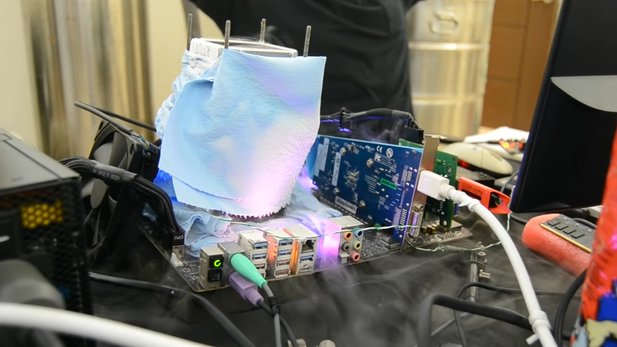
Intel’s Core i9 10900K has only just been released when extreme overclockers are already working with special cooling methods to squeeze everything out of the tens of cores.
The results are remarkable, especially for a CPU with ten cores, so the 10900K seems to be quite clock-friendly. However, higher clock rates quickly ensure that power consumption and temperatures rise significantly.
7.7 GHz on all ten cores & 20 threads
The first official record For the Core i9 10900K, the Swedish overclockers »ElmorLabs«, which are in the service of Asus, were able to achieve. 7,702.62 MHz (7.7 GHz) on all ten cores and 20 threads fetched them from the Comet Lake-S-CPU at a core voltage of 1.194 volts using liquid helium.
What makes liquid helium so special?
Liquid helium is particularly well suited for record attempts because it has a temperature of -269 degrees and is therefore close to absolute zero (-273.15 degrees Celsius or 0 degrees Kelvin). Liquid nitrogen, which is part of the standard repertoire of extreme overclockers, has a temperature of -196 degrees.
The well-known German extreme overclocker and Youtuber novel “der8auer” Hartung has also adopted the i9 10900K (see the video embedded above). However, only a few liters (30 to be exact) of liquid nitrogen were available for his experiment. But even with that, he was able to break the 7.0 GHz mark. The system then became unstable at 7.25 to 7.3 GHz.
In order to be able to better classify the OC potential of the i9 10900K: der8auer has held at 7,613.19 MHz on all cores and threads for a year and a half World record for the Core i9 9900K.
In our test with benchmarks find out what the Core i9 10900K can do under standard conditions and how it beats the Core i9 9900K and the Ryzen 9 3900X:
more on the subject
Core i9 10900K against AMD Ryzen and 9900K
10900K with good overclocking potential
That the i9 10900K generally plenty of scope for overclocking offers, suggested before the release of the Twitter user OldSKol. He wants to have achieved 5.4 GHz on all ten cores using common cooling methods – i.e. air or water cooling.
Wccftech were able to achieve 5.2 GHz all-core in their test of the i9 10900K – also using a standard cooling solution. We achieved this value when overclocking with our test model, but the temperatures were over 90 degrees despite the powerful (air) cooler and open test setup.
In this context, recently known binning statistics from MSI (via Wccftech) interesting about the new Comet Lake-S processors. According to this, around 27 percent of the tested Core i9 10900K and 10900KF can be overclocked well – but a potent cooling solution is mandatory.









